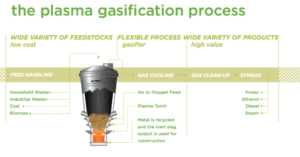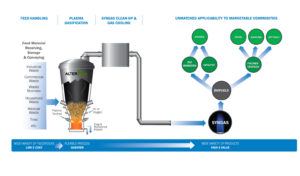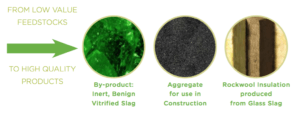‘The Power in Poop’ or ‘A Dirty Source for Clean Energy’

Your sewage can be used to produce clean energy, water, and building supplies through a novel technology called plasma gasification. However, reluctance to change and a lack of regulatory incentives have kept this revolutionary waste processing technique from making its way to your local landfill.
The origins of Municipal Solid Waste (MSW) are attributed to the urbanization that resulted from the Industrial Revolution. Epidemics stemming from crowded industrial cities led to political support for sanitation infrastructure that would include clean drinking water and sewage systems as well as the collection and ‘disposal’ of household refuse.1 Fast-forward one hundred years and you find local landfills contaminating the US countryside and contributing to global warming through greenhouse gas (GHG) emissions.
The proliferation of landfills led to a focus on waste reduction and recycling in the 1980’s. However, MSW management techniques including incineration, compaction, and covering all continue to contribute to GHG emissions. Compaction and covering, for instance, lead to anaerobic conditions that actually increase methane gas emissions per volume. Landfill gas emissions now represent the largest source of GHG emissions from the waste sector and the third-largest source of human-made methane emissions.2

The concept of transforming MSW into energy has been developed through the emerging technology of plasma gasification. This technology can avoid the pitfalls of traditional thermal incineration, and furthermore, the traditional challenges of feedstock inconsistencies that lead to decreased efficiencies have been mitigated through one company’s use of Plasma Gasification technology.

Plasma gasification solution represents a new solution to the timeless problem of waste management. Plasma is a state of matter that can reach temperatures comparable to those found on the surface of the Sun (2,200 to 13,900 °C). At those temperatures, organic matter can be molecularly dissociated and complex molecules can be separated into individual atoms.3 In plasma gasification, a plasma arc (similar to lightning) can be produced by sending electrical charges through inert ionized gas. “This extreme heat maintains the gasification reactions, which break apart the chemical bonds of the feedstock and converts them to a synthesis gas (syngas). The syngas consists primarily of carbon monoxide and hydrogen—the basic building blocks for chemicals, fertilizers, substitute natural gas, and liquid transportation fuels. The syngas can also be sent to gas turbines or reciprocating engines to produce electricity, or combusted to produce steam for a steam turbine-generator.”4

The properties of the temperature and environment can be used to dictate the desired syngas or biofuel. Dr. Ajay Kumar, Associate Professor of Biosystems and Agricultural Engineering at Oklahoma State University writes: “Gasification has many advantages over combustion. It can use low-value feedstocks and convert them not only into electricity, but also into transportation fuels. In the upcoming years, it will serve as a major technology for complementing the energy needs of the world.”5

Technical challenges still remain however, specifically with the quality of feedstock that enters the process. The more inconsistent the feedstock, the more vitrified slag is produced. Slag, however, is a safe and inert material that can be recycled or used as a building material. However, it will have implications on the economic viability of this technology. This is where Alter NRG, has a built an advantage in its licensing of Westinghouse plasma gasification technology. Alter NRG claims that “unlike the typical incineration technology which can process only MSW and similar feedstocks, Alter NRG gasifier can process almost any feedstock including both solids and liquids. Plus, it can process a blend of feedstocks. Project owners can optimize their revenue streams by determining the correct mix of feedstocks based on calorific value and gate fee.”6


While it seems that Alter NRG may have a competitive advantage, the industry as a whole still faces regulatory challenges and has incurred several setbacks in North America. The first waste-to-energy plant was constructed in Japan over ten years ago, however, critics claim that the technology remains untested, and IEEE cites “low electricity prices, and enduring community opposition to any facility that resembles an incinerator” as having “derailed every proposed project in the United States and Canada to date.” 7 Alter NRG has taken steps to address the opposition, such as incorporating the economic impact into its customer value proposition and operational models. “Alter NRG delivers a complete plasma gasification solution to its customers, that utilizes its Westinghouse Plasma Torches. With our engineering and construction partners we can design and construct a complete gasification plant, assisting with technical and commercial support during the entire project development process. Our engineering and construction partners can offer performance guarantees on the entire project facility which truly sets up apart from other earlier stages technologies.” This effort to overcome the reluctance to treat MSW has been mainly through showcasing the economic benefits.

While upfront capital costs of this technology limit its diffusion, I believe that Alter NRG should be looking towards markets where the near-term benefits of energy and water production may be of more value. I would target developing nations in Africa where energy and water is scarce, fertilizers are expensive, yet landfills are rampant. I can still remember the smell of ash that permeates the air in Uganda and many developing nations as trash burns constantly, or in South East Asia where slash and burn farming techniques dominate the countries’ fertilization tactics. This can only be achieved through effective partnerships with the nations governments and ministries of agriculture, but unfortunately, these entities have little motivation to change or shoulder the upfront costs. Additional pressure would need to be placed by the international communities, however, in the meantime, it seems that Alter NRG and the rest of us will remain in a sh***y situation.
1 Helen Spiegelman & Bill Sheehan, Ph.D. ‘Unintended Consequences: Municipal Solid Waste Management and the Throwaway Society’ Product Policy Institute, (pg 4-5), March 2005.
2 Osaka/Shiga. Waste and Climate Change: Global trends and strategy framework. (Pg 18). United Nations Environmental Programme Division of Technology, Industry and Economics International Environmental Technology Centre
3 Wikipedia – Plasma gasification, 2016. Wikipedia https://en.wikipedia.org/wiki/Plasma_gasification
4 Gasification and Syngas Technology Council. Gasification-Syngas.org website 2016. http://www.gasification-syngas.org/technology/plasma-gasification/
5 Kumar, A., D. D. Jones, and M. A. Hanna. 2009. Thermochemical biomass gasification: A review of the current status of the technology. Energies 2(3):556-581.
6 Alter NRG Corp. Company website 2016. “http://www.alternrg.com/waste_to_energy/benefits_advantages/
7 IEEE Spectrum. Non Profit Organization website 2016. .http://spectrum.ieee.org/energy/renewables/surges-and-setbacks-for-trashtogas-electricity



Fascinating! Can this be used for all kinds of waste and trash or mainly for sewage / wastewater?
This is a really interesting post and from my prior experience I’ve seen a lot of companies try to repurpose waste. Organic waste most notably is a key contributor to the environment mainly due to the fact that organic waste such as food waste, etc. releases methane gas, which is a couple times more damaging to the environment than CO2. As such, many companies, mainly start ups are finding ways to divert organic waste to the landfill, as you mentioned in your post. One of the questions that these new methods / technologies begs is the idea of adoption, and how do you actually get it to scale. I was surprise how many technologies actually already exist in the market to do their part in eliminating waste and reusing them in a more eco-friendly way, but it seems like the adoption curve hasn’t hit the exponential growth part yet. Interesting to get your thoughts on how you think companies like this will manage adoption, and what you think is really stopping key stakeholders (mainly consumers) from adopting easily. Is it really as simple as costs? Is it behavior? Is it something else?
Very interesting post, Todd! It seems like the main sticking points are (1) reluctance to change, (2) lack of regulatory incentives to spur this change, and (3) upfront capital costs of implementing this technology. You suggest that developing nations may be the place to prove the technology, hopefully eliminating the issues (1) and (2) present to other countries as the technology is proven throughout the process.
Although these developing countries may recognize outsized benefits from this technology, how would you propose getting over the hurdle of the upfront capital costs that may also be a disproportionately large issue for these developing countries?
Appreciate the novel look at the “power in poop”!
Todd,
I really like this article on “gasifying” waste. I think the logic behind the process is very strong. As mentioned, incinerating produces negative by-products that Alter NRG can avoid. It’s interesting to me that they face such strong opposition which seems to be based on a false premise. It’s also interesting to see that they have agreed to be acquired by a Chinese firm (http://www.rewmag.com/article/harvest-international-alter-nrg-acquisition/) indicating demand for the product.
I believe this product is ahead of its time given its innate strengths. Also, I think your recommendation to concentrate on areas such as South East Asia is strong. However, I think that they may find a strong foothold with utilization if they try to partner with government or the landfills themselves. This may help to circumvent the public opposition.
Todd,
Very interesting technology. Does the feedstock need to consistent for downstream processing? For example, could a city have one large gasifier that handles waste sludge, trash, and biomass? Or would the gasifier and downstream processing technology require more consistent feedstock?
Any data on costs and outputs? It would be interesting to see what type of price environment and capex it would require to be cost effective.
Seems like there is a lot of awareness building that can be done around the new technology that Alter NRG provides. My understanding is the MSW consists of all wastes from an area (household, sewer /drains, general public trash, etc). Is there a process by which this is sorted after (or before) dumping into a landfill? It seems like if the waste can be sorted into different categories of feedstock, we could configure the plasma gasification technology to optimize for energy generation for that particular type of feedstock. I wonder how much effort this would be and how much addition energy could be produced.
After reading your post, I thought of the Deer Island Wastewater Treatment site in the greater Boston area. They use their sludge digester gas for their onsite power plant to create steam and hot water for the facility.
http://www.mwra.com/03sewer/html/renewableenergydi.htm
I wonder if there are opportunities where landfills are located near other energy infrastructure to implement similar technology to Deer Island, and that proponents of plasma gasification would want to focus on stand-alone landfills.
“sh*****y situation” indeed.
Maybe I misunderstood the science here, but it seems like an energy intensive way to deal with trash – don’t you need high levels of energy to heat the trash to temperatures similar to those found on the surface of the sun?
If that first concern has been addressed, then it sounds like this type of energy production and waste removal should have incentives similar to those of solar. Energies should be allowed to include such production in their renewable targets, and/or there should be tax credits for new construction.
Todd, thank you for the thoughtful post! The technology you discuss above sounds extremely interesting. Do you think widespread adoption is feasible? What are the primary barriers to adoption? Certainly, reluctance to change and regulatory hurdles have hindered the process. Your suggestion to start in countries in Africa is an interesting one. Waste management is clearly a major issue, and I do not think we have seen major innovations on this front in quite some time.
In the process of reading these blog posts, yours included, it has become clear that inertia, public perception, and regulation are consistently affecting corporations’ ability to become environmentally impactful in both positive and negative ways. More specifically to your post, this technology is incredibly cool! I wonder if there is data on how many CO2 emissions are avoided collectively by the startups and Alter NRG’s efforts? Additionally, has the Japan implementation of this technology been successful? Either way, are there takeaways from that scenario that could be useful in implementing this technology elsewhere, like in developing nations as you suggest?
Really interesting technology here Todd. It’s a shame it isn’t more widespread but that’s likely due to how capital intensive it seems combined with the perceived risks to a neighborhood/community of any heavy industrial complexes that involve high temperatures. I wonder, how do the lifetime costs of a typical plant compare to that of other renewable energy sources? I think it’s hard for governments to get behind this when other renewable sources such as wind and solar are so much easier to install and operate.